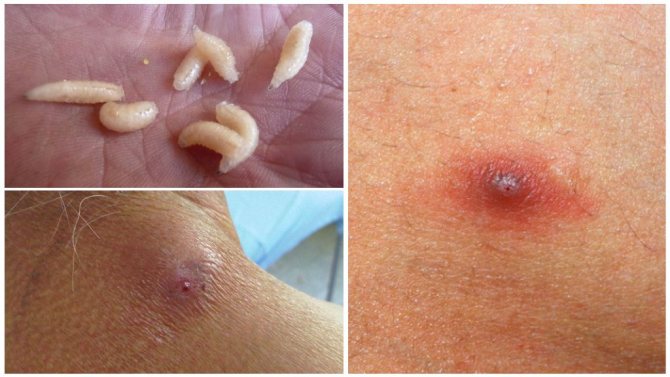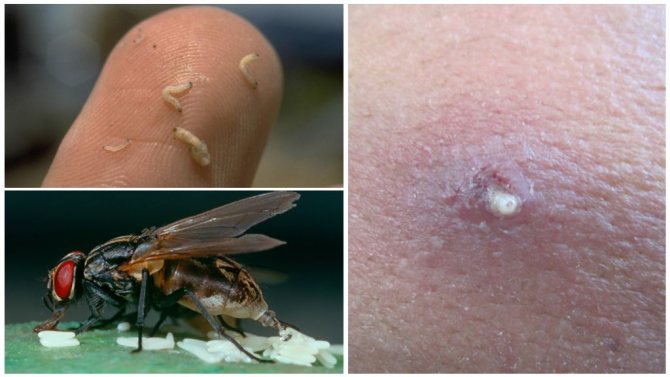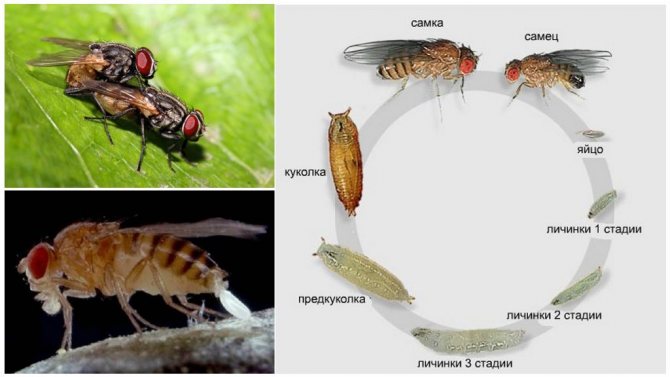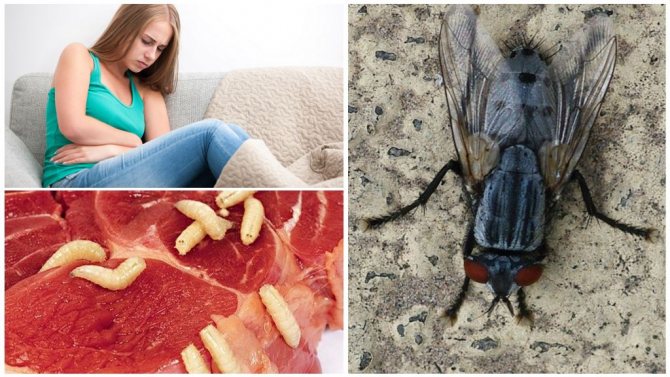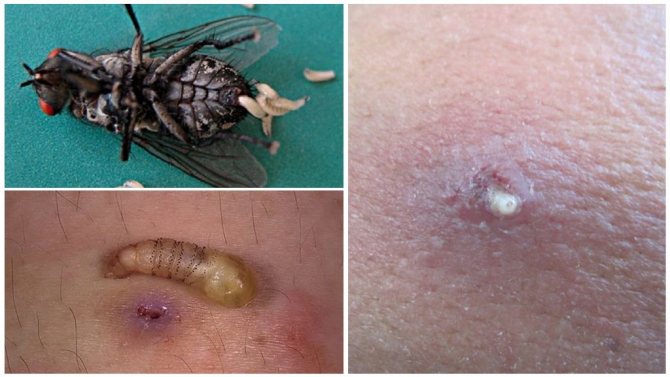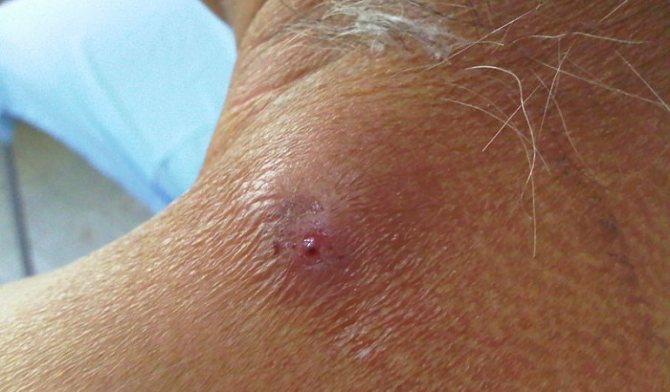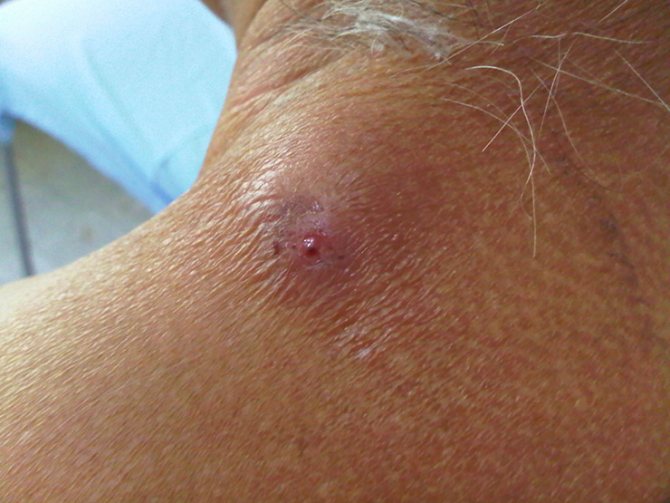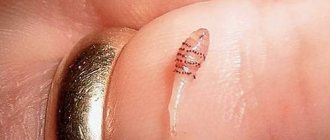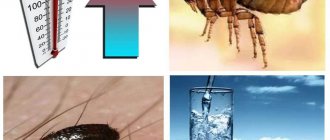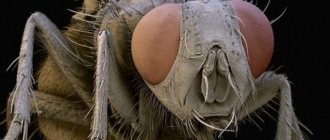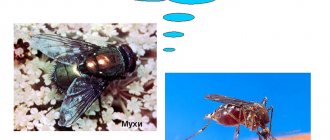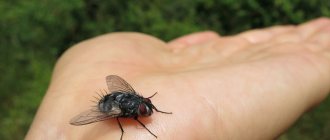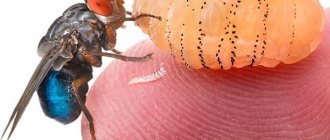Flies are carriers of intestinal infectious diseases: one individual carries more than 6 million dangerous bacteria, including the causative agents of dysentery, cholera, typhoid fever. These diseases cause severe damage to the gastrointestinal tract and can lead to the death of the patient. Another dangerous disease caused by insects is myiasis. The disease develops when the fly lays the larvae under the human skin.
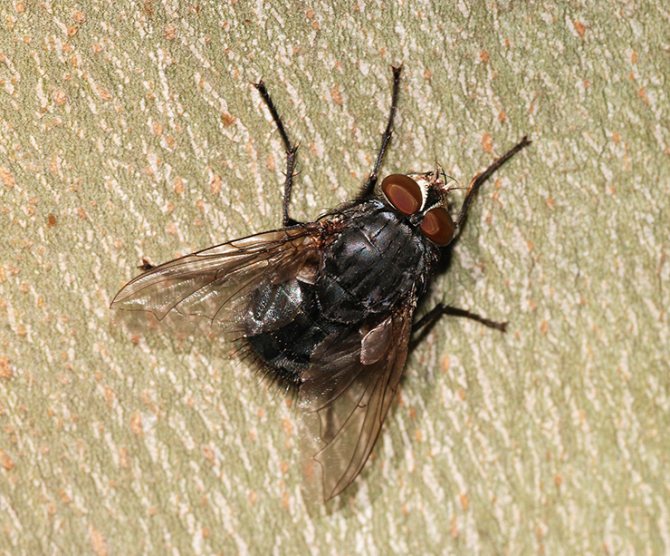
Flies carry many infections
Disease-causing myiasis and flies
Fly larvae in the human body can be found in the most unexpected places. Most often, myiasis occurs after the gadflies lay their eggs. The developmental cycle of these flies presupposes development in the body of the host, which can be not only a large animal, but also a person.
On a note!
All videos and photos in which the larvae are removed from under the skin refer to gadfly lesions.
Myases can be casual, optional, and obligatory. The type of myiasis largely depends on what flies eat in nature.
Diagnostics
Myiasis is often misdiagnosed because it is rare and the symptoms are not specific. Intestinal and urinary tract infections are particularly difficult to diagnose.
Hints that it might be present include:
- recent travel to an endemic area;
- one or more non-healing skin lesions;
- itching;
- movement under the skin;
- pain;
- selection from the center point (tiny hole);
- small white structure protruding from the lesion.
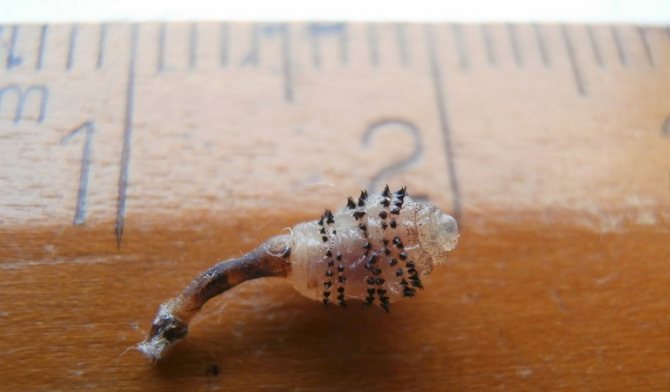

Serological testing is used to diagnose the presence of gadfly larvae in human ophthalmomyosis.
Random
Diseases are caused by flies, usually laying eggs in rotting organic matter. A person becomes infected with these larvae by accident, swallowing them with food or wearing underwear. For the most part, eggs swallowed by a person are dissolved in gastric juice, but sometimes maggot can enter the intestines, causing intestinal myiasis. If the fly has laid on damp laundry, the larva can penetrate the urethra, causing urogenital myiasis.
Accidental cavity myiasis is caused by many flies:
- blue meat (Calliphora vicina);
- indoor (Musca domestica);
- green meat (Lucilla sericata);
- brownie (Muscina stabulans);
- small room (Fannia canicularis);
- fruit flies (family Drosophilidae);
- cheese (Piophila casei).
These are not the only, but the main types of flies that infect humans.
Interesting!
The intestinal myiasis with the larvae of cheese flies is usually arranged by a person himself, eating a dubious delicacy: rotten cheese infected with a cheese fly.
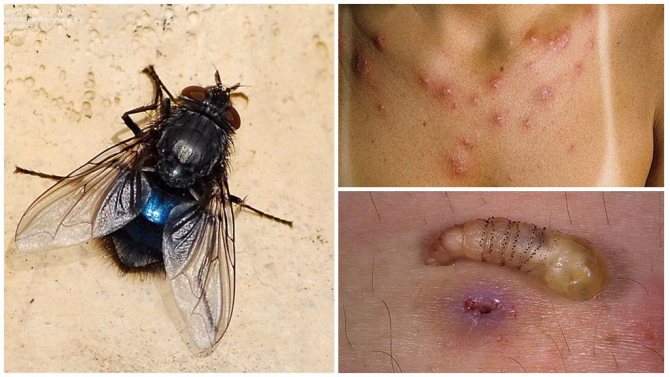

Random myiasis
Parasites that live in humans
It has long been known that almost all diseases of various organs can be caused by the presence of parasites in the body.
Have you been trying to get rid of PARASITES for many years?
Head of the Institute: “You will be amazed how easy it is to get rid of parasites by taking every day ...
Read more "
However, it always seems to each of us that this cannot happen to us. At the same time, every day hundreds of people go to different doctors' offices and cannot find the cause of their illness.
How do parasites enter the body?
Parasites enter human organs in many ways, each of which we meet in everyday life all the time.
Methods for the entry of parasites into the body:
- When eating lightly salted fish or caviar.
- With lard streaked with meat.
- With meat of wild animals.
- With insufficiently cooked meat.
- With smoked meat and fish.
- With herbs, vegetables and fruits, which were poorly washed before use and not scalded with boiling water.
- When walking barefoot on the grass, on the area fertilized with manure.
- From pets.
- Insects such as flies can carry eggs.
Signs of a parasite infestation
After studying the ways in which parasites enter the human body, almost every inhabitant of the planet finds himself in the so-called risk zone.
However, there are certain symptoms, the presence of which may mean that a parasite lives inside the human body:
- Bowel disorders.
- Constipation. It is caused by parasites that have been in humans for a long time and have reached large sizes, blocking the intestines, thereby preventing the stable functioning of the body.
- Diarrhea. Loose stools can also be a sign of parasites in the body. The cause of diarrhea can be a parasite, which secretes substances poisonous to humans during its life, which, among other things, can cause liquefaction of feces.
- Flatulence. The cause of these disorders can be worms in the human body, which cause inflammatory processes in the course of their life.
- Bowel disease. The parasites living inside a person absorb most of the beneficial nutrients from the body. In addition, parasitizing inside the human body, worms lead to a malfunction of the well-coordinated functioning of the body. So, for example, the organs cease to properly assimilate fat, as a result of which it appears in the large intestine, further in the feces, which leads to a violation of the stool.
- Joint and muscle pain. Very often, these painful sensations, very similar to those experienced by a person with arthritis, are caused by the fact that the immune system, trying to expel parasites from the body, causes inflammatory processes in them, which are the causes of pain.
- Allergy. Often the causes of dermatitis, papillomas, eczema and all kinds of skin rashes are parasites that have been living in the body for a long time. Allergy is a certain signal to a person. Inside the body, the immune system, producing a large number of eosinophil cells for the purpose of protection, causes inflammatory processes, which lead to problems of the human skin.
- Anemia. This disease, caused by severe blood loss, can also develop as a result of the "activity" of parasites. Trichomonas, living in the intestinal mucosa, feeds not only on the nutrients of the body, but also on blood. That is why, during mass reproduction, such parasites in an infected person, living mainly in blood cells, can lead to significant blood loss.
- Weight problems. Any metabolic failure can be caused by the vital activity of worms. They can both disrupt metabolism and cause weight loss, or, by consuming most of the glucose, cause excess weight.
- Increased irritability and irritability. The vital activity of intruders in the human body cannot go unnoticed by the nervous system. Many parasites release toxins that can irritate the nervous system as well. This can cause depression and frequent irritation.
- Fatigue. Lack of nutrients in humans, caused by the presence of "gluttonous" worms, can lead to disruption of the immune system, as a result of which the person lacks energy.
- Insomnia. At night, mainly between two and three o'clock in the morning, the liver tries to cleanse the body of toxins, so at this time the parasites can escape through the anus. This process causes irritation and insomnia.
- Bruxism (teeth grinding while sleeping). This symptom is common in children. This phenomenon is caused by the reaction of the nervous system to the toxic waste products of the worms that live in the child's body.
- Immune disorders.The existence of parasites in the body causes a weakening of the body's immunity, which spends all its strength in the fight against intruders. In the meantime, any infection can easily get into a weakened human body.
- Airways. There, irritating the bronchi, they can cause a runny nose and cough in a person, which subsequently leads to an increase in body temperature and diseases such as asthma and pneumonia.
- Oncology. Parasites that live in human organs for a long time manage to cause serious damage to the tissues of internal organs, which causes inflammation and slows down the work of the whole organism and leads to negative consequences.
Diagnostics
In the 21st century, everything can be diagnosed, including the presence of parasites inside a person. Anyone can pass all the necessary tests and accurately establish the presence or absence of flukes in the body.
Modern medical techniques are able to determine the presence of intruders in the body in many ways.
Diagnostic options:
Stool analysis (it must be repeated at least 3 times, while there are certain periods of time in which it is better to take the analysis).
- Enzyme-linked immunosorbent assay (ELISA).
- Immunoassay tests (ELISA tests).
- Serological research methods.
- Ultrasound of internal organs.
- Endobiopsy.
- PCR diagnostics that can establish the presence of parasites in a person based on the study of DNA analysis.
It should be noted that the treatment of parasitic diseases should be carried out strictly under the supervision of a doctor who will prescribe a course of treatment. This type of disease, along with others, should not be treated on its own.
Parasite classification
Below is a complete classification. The class is protozoal (protozoal) microorganisms, this class includes:
- Dysentery amoeba, which causes diseases such as amoebiasis.
- Intestinal balantidiasis, causing balantidiasis.
- Leishmania (leishmaniasis).
- Giardia (giardiasis).
- Plasmodium falciparum (malaria).
- Toxoplasma (toxoplasmosis).
- Trichomonas (trichomoniasis).
Class of worms (helminths), these include:
- Ascaris (ascariasis).
- Opisthorchiasis (opisthorchiasis).
- Pinworms (enterobiasis).
- Ankystoloma (hookworm).
- Schistosomes (schistosomiasis).
- Anisakida (anisakidosis).
- Trichinella (trichinosis).
A class of ectoparasites (living on the surface of the body), these include:
- Louse (head lice).
- Scabies itching (scabies).
- Acne mite (demodicosis).
Types of parasites
In order to roughly imagine the scale of the vital activity of parasites in the human body, let us take a closer look at some of them.
Toksokara - initially this parasite multiplied and lived exclusively in the organs of the digestive system of dogs. However, recent studies have shown that now a huge number of people, mainly pet owners, are carriers of toxocara.
The length of an adult toxocara, living inside an adult organism, reaches 30 cm. Toxocara reproduces with the help of eggs that penetrate into the dog's feces.
The excrement of a four-legged animal falls into the ground and sand, where toxocara eggs can be stored for up to several years. From there, parasites penetrate a person through the soles of shoes, the floor and the hands of children touching everything on the ground in a park where dogs are walked.
Once in the human body, the parasites are no longer able to multiply further inside the body, since the toxocara larvae mature, spread through the vessels and internal organs, but do not stand out outside.
You will be surprised how many parasites will come out if you drink a glass of ordinary in the morning ...
The parasites will leave the body in 3 days! You just need to drink on an empty stomach ...
To diagnose the presence of this parasite in a person, it is necessary to pass a biopsy of the affected organs (usually the liver) and immunological tests.
It is worth noting that if toxocara gets into the eye, it can be removed! Symptoms in the presence of this parasite in the human body are similar to others.
Ascaris is a type of parasite that enters the human body with unwashed vegetables and herbs, dirty hands, dust, and can be carried by flies.
According to some reports, this parasite affects about hundreds of millions of people every year.
The length of the roundworm reaches 40 cm, and only one female releases about 200,000 eggs every day. Also, ascaris, having entered the human body in the form of an egg, grows into a larva, then grows in the intestinal wall, from there it enters the bloodstream, and from there it enters any organs, including the liver, heart, brain.
Ascaris is very dangerous, because in the course of its life it can be in any organ, damaging it and causing serious diseases. This parasite can successfully inhabit the blood of a person, as a result of which an infected person may develop anemia or anemia. The symptoms of the presence of this worm in the body are similar to most.
Ascaris can be diagnosed with the help of feces studies at least 3 times, as well as with the help of immunological tests in the larval period.
The broad tapeworm is a parasite that grows up to 10 meters inside the human body. Such a worm can live inside a person for about 25 years. The tapeworm can get into the body when eating raw fish, crayfish and caviar. It is worth noting that such a large parasite in the body cannot live unnoticed by humans.
Signs of its presence are quite obvious, among them active salivation, mainly in the morning, anemia, exhaustion, abdominal pain, vomiting, nausea, weakness, lethargy and drowsiness.
A feature of the tapeworm is the exit in the usual way with a person's feces of a part of the parasite. This is what, as a rule, helps a person who did not pay attention to the symptoms to diagnose the presence of the parasite in the body without tests.
Prophylaxis
By observing the simple basics of prevention, you can minimize the chances of an uninvited guest appearing in your body and in your child's body.
Prevention of parasite infestation:
- Observe basic rules of personal hygiene.
- Eliminate contact with stray animals.
- Avoid contact of children with infected pets.
- Minimize the contact of the child during a walk with the places where pets are walking.
- Wash hands after outdoors and before every meal.
- Avoid eating while walking.
- Frequent wet cleaning of the apartment.
- Eat only well-washed vegetables and fruits, scalded with boiling water after that.
- Eat meat products only after full heat treatment, sufficient to prepare safe meals.
- Drink only boiled water.
- In the presence of pets, at least once every six months, carry out preventive measures.
Intestinal myiasis
In addition to these species, intestinal myiasis can be caused by almost any fly. But this type of disease takes the most serious forms when it is affected by fruit flies and cheese flies.
Symptoms:
- irritation and inflammation of the intestinal mucosa;
- abdominal pain;
- diarrhea with larvae;
- exhaustion;
- sharp pain in the anus;
- vomiting with larvae.
On a note!
Adult maggots reach a length of up to 1.5 cm. Treatment is prescribed after diagnosis and is carried out with anthelmintic drugs against nematodes.
Treatment
Myiasis treatments are applied as soon as the infection is established. First aid is to tightly cover the air hole in the skin with petroleum jelly. Lack of oxygen pushes the larva to the surface, where it is easier to deal with.
Warm compresses or injection of lidocaine under the larvae have been reported to bring the parasites to the surface.
In a clinical or veterinary setting, there may not be time for such preliminary approaches, and the choice of treatment is more direct, with or without an incision.The larva must first be removed by applying pressure around the lesion and using forceps.
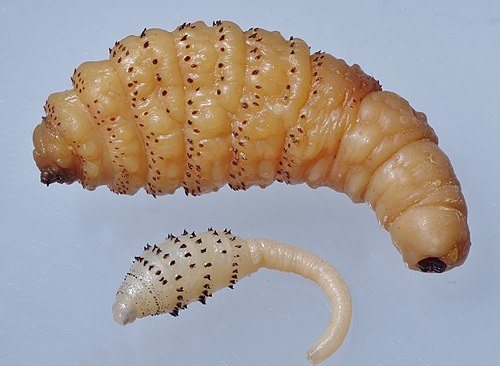

Second, the wound must be cleaned and disinfected. Further monitoring is necessary to avoid re-infection.
Livestock are treated prophylactically with drugs containing ivermectin. It provides long-term protection against larval development.
Sheep are treated with a persistent insecticide before they become a problem.
Genitourinary myiasis
After the larvae enter the human urethra, severe pains begin in the urinary canal, often with urinary retention. For treatment, the urethra is washed.
This disease can be caused by any kind of dipteran insects, but tourists who went on a safari to Africa often suffer from it. The Congo area is home to the mangrove fly, which lays eggs on wet vertical surfaces.
The local population is aware of this feature of the insect and dries clothes by laying them out horizontally. Tourists who do not understand the reason for this custom, hang their linen on the ropes. And they get a cavity urogenital myiasis.
Other meanings of this word:
Random riddle:
A bullet flies, buzzes, I'm sideways, she follows me, I'm in another, she follows me, I grab! And what is it?
Random anecdote:
Have a bench of the student hostel bored two cops: - Wan, let's beat the Neck! - says the first. - What for? - the second is surprised. - And it’s interesting, do they have bruises?
Did you know?
The length of the capillaries of the human body, stretched out in one thread, is about 100 thousand kilometers. This is more than 10 times the distance from Moscow to Vladivostok.
Scanwords, crosswords, sudoku, keywords online
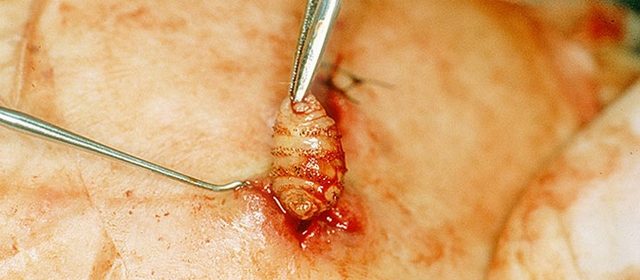

Myiasis is a group of diseases caused by parasitic larvae of flies and other insects in human and animal tissues. They affect various tissues, leading to dysfunction, serious complications, up to the loss of an organ. Timely treatment is always positive, and the disease recedes in a short time.
Optional myiasis
This group of diseases is caused by flies, which normally breed on animal corpses. They cannot lay eggs in a person in the literal sense of the word. Insects lay eggs either in open wounds or on intact skin, ears or nose.
On a note!
Flies do not have an ovipositor that can pierce the skin. Therefore, all photos of a fly laying larvae under the skin are processed with Photoshop.
The hatched larva itself penetrates the epidermis and develops there for 2-3 weeks. The finally developed maggots leave the body and fall to the ground. There they pupate and after a while adults emerge from the pupae.
Depending on the place where the laying was made, the larvae penetrate not only under the skin, but also into the eyes, nasal cavities and skull. In this case, the expression "ate the brain" ceases to be figurative. The maggots that penetrate the cranial cavity feed on the brain tissue.
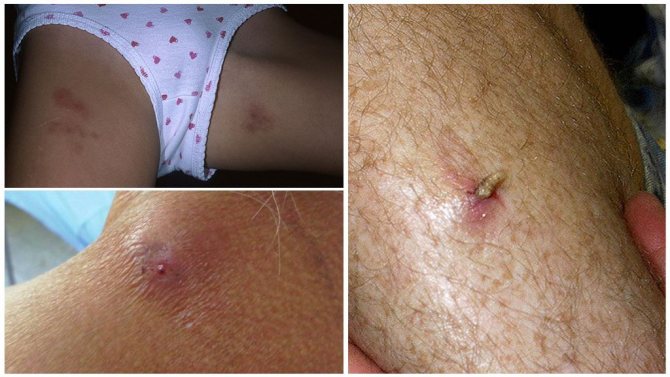

Optional myiasis
If the fly larvae get into the eye, they can only be removed surgically. The easiest variant of ophthalmomyasis is the penetration of maggot into the conjunctiva. Upon penetration into the eyeball, the disease may result in the loss of the organ of vision.
On a note!
In the United States, there have been cases of gray blowfly maggots penetrating deep into the internal tissues of the body.
Removal of fly larvae from under the skin, from the nose and eyes is possible only by surgery.
Larva therapy
Throughout history, larvae have been used therapeutically to cleanse necrotic wounds.
Fly larvae, feeding on dead tissue, cleanse wounds, reduce bacterial activity and the likelihood of secondary infection. They dissolve dead tissue by releasing digestive enzymes into the wound.Dead tissue is actively eaten with the help of mouth hooks, two hard, probing appendages protruding on either side of the "mouth".
Read more Fly Bite Symptoms and Treatment
Maggot therapy - is the deliberate introduction by a practitioner of live, disinfected larvae into non-healing skin and soft tissue wounds of a human or animal for the purpose of selectively cleaning necrotic tissue in the wound to promote healing.
Although larval therapy has been used in the United States for the past 80 years, it was not approved by the FDA until 2004 (along with leeches). These are the first living organisms that are approved for the treatment of neuropathic (diabetic) foot ulcers, pressure sores, venous ulcers, traumatic, postoperative wounds that do not respond to treatment.
The larvae of the green fly are raised exclusively for this purpose, as they consume only necrotic tissue, leaving healthy tissue intact.
This is an important distinction, as most of the other major species of myasitic fly larvae attack both living and dead wound tissue indiscriminately, effectively negating the benefits of neutralizing non-hazardous wounds.
Medicinal larvae are applied to the wound and covered with a sterile gauze and nylon mesh bandage. Too many larvae placed on a wound can eat up healthy tissue.
History
Larval therapy has a long history and background. The indigenous people of Australia used it, as well as the peoples of the mountains of northern Burma, the Mayans of Central America. Surgeons in Napoleon's armies have recognized that wounded soldiers with myiasis are more likely to survive than those who are not infected.
William Baer, orthopedic surgeon, Johns Hopkins in the late 1920s, used maggot therapy for patients with osteomyelitis, bone marrow infection. The idea was based on experience
World War I, where two soldiers showed him the spliced thigh bones after they lay on the ground for seven days without food or water. Baer could not understand why no one had a fever or signs of sepsis.
I noticed: “Having taken off my clothes from the wounded unit, I was very surprised to see a wound filled with thousands of larvae, apparently from a fly bite. The sight was very disgusting. Measures were taken to wash away these disgusting looking creatures. " However, then I saw that the wounds were filled with beautiful pink granulation tissue and healed well.
Fly larva therapy was common in the United States during the 1930s. However, in the second half of the twentieth century, after the introduction of antibiotics, it was used only as a last resort for very serious wounds. Recently, this method of treatment is returning due to the increased resistance of bacteria to antibiotics.
Why Accidental and Optional Myiasis Occur
The main cause of these types of disease is the usual unsanitary conditions. Neglect of personal hygiene and cleanliness of the premises leads to the multiplication of flies, which sooner or later will lay a clutch on humans.
Obligate myiasis
Caused by flies, originally parasitic on warm-blooded organisms. Their other name is gadfly. The breeding cycle of different individuals may include parasitizing maggots in the stomach, nasal sinuses, or skin.
The gastric gadfly sticks eggs to the forelimbs of herbivores. When an animal scratches its leg, it inadvertently swallows eggs, which begin to develop in the gastrointestinal tract. Gastric gadfly eggs do not die in the intestines, but humans have little chance of contracting these parasites. Disease is treated with planned deworming of animals. The person is also helped by standard anthelmintic drugs.
The subcutaneous gadfly usually also attacks large herbivores, laying eggs, 1 piece per wool. He does not have a definite point of attachment of the egg.The hatched larva is drilled into the skin and begins feeding on the host's flesh. Before the transition to the second stage of development, it makes a subcutaneous path to the region of the animal's back, where it forms a nodule with an opening for air.
A hypodermic gadfly can also lay a clutch on a person. In this case, the larvae begin their instinctive upward movement, going not to the back, but to the head of the host.
Important!
There are known cases of fatal penetration of this species into the human brain.
Subcutaneous myiasis
The main cause of this disease is the larvae of subcutaneous gadflies. Signs of subcutaneous myiasis in humans are red swellings with a hole in the middle. The activity of the larva causes pain in the host.
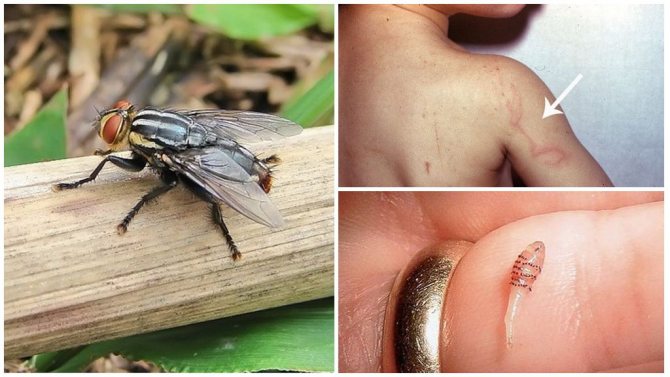

Subcutaneous myiasis
To remove parasites, the airway is first covered with an airtight plaster. In an attempt to breathe, the larva pokes its head into the hole. A day later, the plaster is removed, the crawled larva is hooked with tweezers and carefully pulled out. This procedure is carried out only in humans. In animals, the nodules are simply opened.
Nasopharyngeal gadflies
These types of parasites are viviparous. They do not lay eggs, but inject ready-made live larvae into the nostrils, mouth and eyes of animals and humans. Once on the mucous membranes, the parasites invade the victim's body, causing cavity myiasis in the nose and damage to the eyes and mucous membranes of the mouth. Localization of the offspring of the nasopharyngeal gadfly occurs in the frontal and nasal cavities, pharynx, ethmoid bone. The same larvae parasitize the mucous membranes of the eyes and mouth and penetrate the eyeballs.
Prophylaxis
The first prevention method aims to kill adult flies before they can cause damage. The second method is post-infection treatment, which affects infected animals (including humans).
Learn more Pinworms (enterobiasis) in adults and children-diagnosis, treatment and prevention
The main method for controlling adult populations of myiasis flies involves the use of insecticides where livestock are kept. Organophosphate or organochlorine compounds are used for spraying.
One of the alternative methods of prevention is the sterile insect method (SIT). A significant number of artificially grown sterilized (usually by irradiation) male flies and mosquitoes are introduced. Males compete with wild individuals for females. Females lay batches of unfertilized eggs that cannot develop into the larval stage.
One of the prevention methods is to remove the environment most favorable for flies, for example, by removing the tail, hair around the tail, between the hind legs. Another, more permanent practice that is used is mulling.
To prevent myiasis in humans, it is necessary to generally improve sanitation, personal hygiene, and kill insects with insecticides. Clothes should be thoroughly washed, preferably in hot water, dried and ironed thoroughly. The heat kills the eggs that cause disease.
Preventive measures
- To prevent these types of diseases, it is important to comply with sanitary and hygienic requirements. And monitor the purity of the products.
- If you have pets in your home, it is important to monitor their health and heal wounds in time.
- If a person has open wounds on their body, then the dressings should be changed regularly.
- It is better to clean the room with disinfectants.
Timely measures will positively affect the cure of the disease. But it's better to take care of your health in advance!

